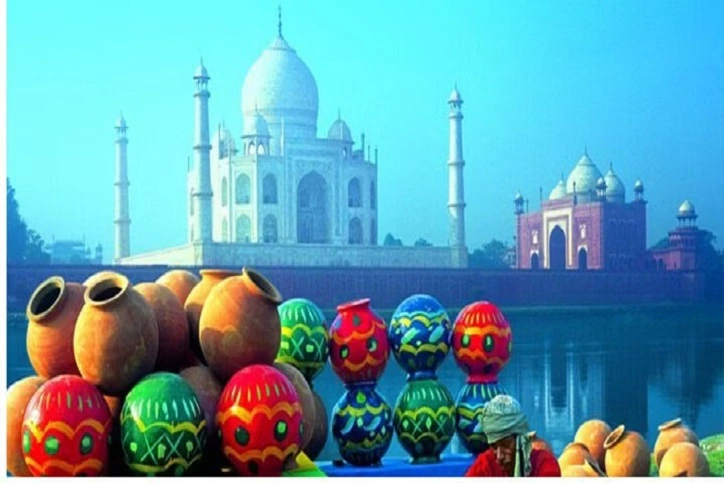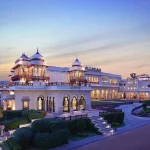From February 18 to March 2, 2025, the historic city of Agra will once again host Taj Mahotsav 2025. This grand Taj Mahotsav Festival celebrates the vibrant traditions, arts, and crafts of India. Organized near the eastern gate of the Taj Mahal, the event unites artisans, performers, and food lovers from every corner of the country. Over 10 days, visitors can enjoy folk music, dance shows, craft exhibitions, and culinary delights, experiencing a captivating snapshot of India’s diverse heritage.
Unlike many fairs, Taj Mahotsav in Agra stands out by preserving authentic cultural elements. Taj Mahotsav has expanded under the guidance of the Uttar Pradesh Tourism Department. Each year, fresh themes highlight facets of India’s heritage, from classical dance forms to regional food traditions.
Origins and Growth of Taj Mahotsav Agra
The origin of Taj Mahotsav dates back to 1992, when it aimed to showcase regional artisans and boost tourism. Over the years, Taj Mahotsav Agra has grown into one of the region’s most anticipated cultural events. It typically opens with an inaugural ceremony featuring folk dances, live music, and a procession echoing Mughal-era pageantry. Following this, daylong stalls, exhibitions, and concerts engage visitors from morning till late evening. For local craftsmen, the event is invaluable, offering a direct way to promote artworks to a global audience.
Dates, Fees, and Venue
For Taj Mahotsav 2025, the festivities extend for 13 days, giving attendees ample time to explore. Entry fees for the Taj Mahotsav Festival are set at INR 50 per Indian adult, while children under three enter at no cost. Foreign tourists also enjoy free admission, encouraging international participation. School groups of up to fifty students in uniform receive a collective entry of INR 700, which includes two complimentary passes for teachers. These pricing policies ensure that families, students, and global visitors all have equal opportunities to join the celebration.
Held at Shilpgram near the Taj Mahal’s eastern gate, Taj Mahotsav in Agra transforms this cultural festival into a vibrant arena. Zones include artisan exhibits, live performance stages, and food courts serving a variety of Indian specialties.
Festival Highlights & Activities
1. Handicrafts and Artisan Stalls
Though the festival’s focus is often on dance and music, the handicraft stalls are equally captivating. Artisans from different states congregate to showcase a wide range of specialties, everything from brass lamps to intricately embroidered fabrics. Shoppers with an eye for detail will find that the best time to browse is shortly after the venue opens in the morning. Fewer crowds in these earlier hours allow you to interact one-on-one with the makers, learn about the heritage behind each product, and avoid the rush that builds toward midday.
2. Musical and Dance Performances
Taj Mahotsav Agra’s cultural program includes both classical and folk genres. In the afternoon, expect to see performers in traditional attire demonstrating regional dance styles. These might range from Kathak footwork to the spirited beats of Bhangra. As twilight approaches, the main stage takes center focus. Fusion bands, classical soloists, and folk troupes all elevate the atmosphere into a lively crescendo. For a closer look at these performances, check the daily schedule at the information desk. It outlines showtimes, enabling you to plan your day around specific acts.
3. Culinary Culture
A broad selection of local dishes and national specialties awaits in the food zone. Sample sweet and savory treats from various corners of the country, from piping-hot chaats to slow-cooked Mughlai curries. The carnival-like atmosphere is enhanced by sweet shops offering items such as jalebi, rabri, or Agra’s signature petha. Vegetarians can find hearty North Indian thalis, while non-vegetarians can relish sumptuous kebabs, biryanis, and more. Many visitors enjoy pacing their food adventures throughout the day, trying small portions at each stall to maximize variety.
4. Workshops and Demonstrations
You will also find workshops led by master artisans who demonstrate their craft. Visitors often learn basic pottery techniques, fabric painting, or the intricacies of handloom weaving. These sessions are perfect for those wishing to gain hands-on experience rather than just observing from a distance. Spaces can be limited, so inquire early if you’re keen on a particular craft. By the session’s end, you’ll likely walk away with new skills and possibly a handmade souvenir.
5. Funfair and Adventure Section
Alongside the cultural core of the event, a funfair caters to those seeking entertainment beyond performances and crafts. Expect classic carnival rides such as Ferris wheels, carousels, and perhaps even a few thrilling roller-coaster loops. In previous editions, some festival organizers experimented with activities like hot-air ballooning or small-scale adventure sports. While these are subject to change each year, it’s worth keeping an eye out if you enjoy a quick adrenaline rush.
Tips for Visitors
- Arrive Early
Aim to enter the Taj Mahotsav Festival soon after it opens at around 10:00 AM. You’ll avoid midday crowds, have ample time to explore craft stalls without rush, and even grab prime seating for afternoon stage shows. - Plan Your Evenings
The festival’s rhythm intensifies post-sunset, when featured artists perform. If there’s a certain dance or music style you’re eager to see, consult the official schedule and reach the main performance area early for good seats. - Cash vs. Digital Payments
While many stalls now accept digital transactions, small artisans may prefer cash. Carrying smaller denominations ensures smooth purchases without the constant need for change. - Hydration and Footwear
Comfortable shoes are essential, as you’ll be on your feet for extended periods. Keep a reusable water bottle handy; though drinking water facilities are available on-site, queues can form during peak hours. - Combine with Local Sightseeing
Since you’re already in the vicinity of one of India’s most historic cities, consider weaving additional exploration into your schedule. An Agra Tour can easily include the monumental Agra Fort or lesser-known marvels like Itimad-ud-Daulah’s tomb.
Exploring Beyond the Festival
No trip to this heritage-rich area is complete without stepping outside the festival grounds to appreciate Agra’s timeless wonders. If your schedule allows, consider a Day Trip to Agra that goes beyond the immediate locality:
- Taj Mahal at Sunrise or Sunset
The Taj Mahal is often busiest in mid-morning, so visiting at dawn or dusk allows you to see its marble façade bathed in soft light. This iconic structure is the reason millions travel from around the world, and the festival forms a complementary cultural add-on rather than the entire destination. - Agra Fort
A UNESCO World Heritage Site, Agra Fort boasts immense red sandstone walls that encircle beautiful palaces, audience halls, and mosques. The fort was historically significant during the Mughal era, serving as both a defensive structure and a royal residence. - Fatehpur Sikri
Located around 40 kilometers from Agra, Fatehpur Sikri was once the Mughal capital under Emperor Akbar. Today, its grand courtyards, palaces, and the famous Buland Darwaza stand as remarkable testaments to Mughal planning and architecture. If you have multiple days in the city, it’s well worth a half-day visit.
For a more lavish itinerary, a Luxury Golden Triangle Tour can seamlessly connect Agra with Delhi and Jaipur, offering a comprehensive look at North India’s heritage. This route highlights Mughal, Rajput, and British colonial influences. Meanwhile, the Uttar Pradesh Tour might take you further, connecting you with Varanasi or Lucknow to explore distinct cultural and historical dimensions.
Travel Logistics and Transport
Reaching Agra is straightforward whether you’re traveling domestically or internationally. The Kheria Airport offers limited flights, so many opt to arrive via New Delhi’s Indira Gandhi International Airport and then travel by road. Modern highways connect the two cities, making a car journey convenient and efficient. If your aim is comfortable, self-directed travel at a lower cost, cheap car rentals can be arranged to streamline your experience. This way, you can independently navigate between your hotel, the festival venue, and prominent landmarks.
If you prefer all-inclusive planning, look into customized tour packages in India, where reputable operators handle accommodations, transport, and expert guides. These can be especially beneficial for those new to the region, who might be more comfortable having day-to-day details well-organized. Alternatively, group tours in India cater to those who enjoy traveling with like-minded individuals—perfect for forging new friendships and sharing cultural discoveries along the way.
For a truly specialized approach, certain agencies design custom tours that revolve around niche interests, such as architectural photography or gastronomic exploration. If you’re captivated by the festival’s crafts, for instance, you could coordinate a visit to local artisan workshops to observe how these beautiful items are produced year-round.
Final Thoughts
From its elaborate handicrafts to mesmerizing cultural performances, Taj Mahotsav festival is a testament to India’s vast and enduring artistic legacy. Over the years, the event has transformed into a multifaceted carnival that draws in travelers, history enthusiasts, and art lovers alike. Its timing—coinciding with pleasant February weather—further enhances the experience, letting you roam the open-air grounds comfortably throughout the day.
With these points in mind, your time at the festival can be truly transformative, providing a warm, welcoming window into the heart of India’s cultural soul.



